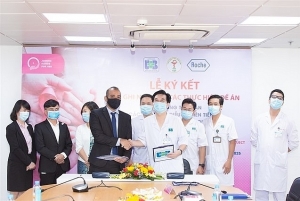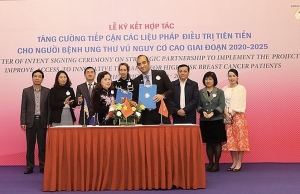Innovative solution for breast cancer patients during COVID-19 pandemic
 |
| Breast cancer patients need timely and appropriate treatment |
Health experts said that cancer patients have a higher risk of catching COVID-19 than people without cancer. Due to their weakening immune system and health reduction due to cancer and chemotherapy, cancer patients are at a larger risk when infected with COVID-19.
Difficulties for cancer patients during pandemic
As the pandemic situation gets complicated, hospitals have more COVID-19 cases, including the ones that treat cancer patients, forcing them into lockdown. Many measures have been introduced to help cancer patients continue receiving treatment during the pandemic.
In order to minimise the possibility of infection, doctors at many hospitals will provide patients with guidance and coordinate with oncology facilities near the patients to monitor their treatment regimen during this time.
One of the effective solutions applied recently is the telehealth application issued and deployed by the Ministry of Health to help cancer patients located far away from major hospitals to receive treatment at cottage hospitals to avoid travel. This way, even when central hospitals come under lockdown, patients can continue their treatment.
Currently, the telehealth system has connected over 600 hospitals and medical facilities, including many major hospitals across the country such as K Hospital, Hanoi Medical University Hospital, Hanoi Oncology Hospital, National Hospital of Tropical Diseases, Hanoi Heart Hospital, and Bach Mai Hospital.
 |
| Telehealth application can help cancer patients |
In Singapore, two initiatives that focus on cancer patients have been launched by the National Cancer Centre Singapore (NCCS) for better navigation in “the new normal”: Home Care and Telemedicine. The Home Care program was first piloted in breast cancer patients using treatment with subcutaneous injection of Trastuzumab. It was well-received and more than 100 patients enrolled in the programme.
The NCCS has also incorporated with a team of trained nurses from mobile healthcare company Jaga Me for the treatment. Medications are collected from the NCCS by the nurses and delivered to the patient's home. The nurses will first assess the patient's vital index (temperature, blood pressure, heart rate) before administering the injection and monitoring the patient for at least 15 minutes before leaving their home.
Advantages of subcutaneous injection in breast cancer treatment
According to statistics by the Global Cancer Observatory (GLOBOCAN) in 2020, Vietnam has 182,563 new cancer cases each year, including 21,555 new cases of breast cancer, accounting for 11.8 per cent. The treatment of breast cancer requires a combination of multiple methods: surgery, chemotherapy, radiation therapy, immunotherapy, targeted therapy, and endocrine therapy.
Most cancer drugs are administered intravenously. With the conventional intravenous injection, there are many drawbacks such as damaging peripheral veins, risk of drug leakage due to inaccurate injection, limited mobility in the area where the needle is placed, long infusion duration that can take a whole day, which reduces the quality of life and wastes the patient’s time.
Subcutaneous injection is a technique commonly used across key hospitals and medical facilities. It uses a needle to inject a small amount of drug solution into the connective tissue under the skin of the patient’s abdomen, thighs, or arms.
Currently, most major oncology hospitals and general hospitals have drugs for the targeted treatment of breast cancer through subcutaneous injection. The benefits of subcutaneously targeted drugs include being minimally invasive and not requiring central venous catheterization. It also requires no drug preparation and dosing due to the fixed dosage used for immediate injection, with the duration of around two to five minutes, shortening the patient's treatment time in hospital.
With these advantages, using subcutaneous injections combined with telehealth offers effective help for breast cancer patients to receive good treatment amid the ongoing escalating pandemic. Not only is there less pain, subcutaneous injection also gives correct and adequate treatment to patients without having to travel too much, shortens their time in hospital, limits contact with other patients, and reduces the chance of COVID-19 transmission. It is predicted that in the future, this method will be applied on a larger scale given its potential.
| Ho Chi Minh City Oncology Hospital joins project on improving breast cancer treatment |
| Ministry of Health and medical association sign MoU to implement breast cancer project |
What the stars mean:
★ Poor ★ ★ Promising ★★★ Good ★★★★ Very good ★★★★★ Exceptional
 Tag:
Tag:
Themes: Healthcare Platform
- Takeda Vietnam awarded for ongoing support of Vietnam’s sustainability efforts
- Self-care signals shift towards sustainable healthcare
- DKSH to acquire Vietnamese healthcare distributor Biomedic
- Two national hospitals expand capacity with new facilities
- Vietnam moves to enhance disease prevention, equity, and sustainability
Related Contents
Latest News
More News
- Ho Chi Minh City hits $8.37 billion in FDI (December 29, 2025 | 08:28)
- Tax sector wraps up 2025 and sets priorities for next year (December 25, 2025 | 14:00)
- Heavy industries set for pilot greenhouse gas quotas (December 25, 2025 | 10:00)
- $250 million deal targets women-owned SMEs, sustainable agriculture (December 22, 2025 | 17:40)
- UOB sees Vietnam growth easing in fourth quarter (December 22, 2025 | 17:39)
- Government moves to establish International Financial Centre (December 21, 2025 | 21:00)
- Vietnam's IFC to target global investment flows (December 21, 2025 | 18:00)
- Ha Tinh breaks ground on major Vingroup industrial and energy projects (December 19, 2025 | 18:24)
- EVN launches major power infrastructure projects nationwide (December 19, 2025 | 18:17)
- VAL inaugurates second production line to meet domestic animal feed demand (December 19, 2025 | 16:37)





























 Mobile Version
Mobile Version